When Bill McKibben‘s ideas about eating local swept the state about ten years ago, Nik and I jumped right in. I have a tremendous feeling of gratitude when I sit down to a meal and I can look over the table at foods of which I know the provenance. I am grateful for the expertise our farmer has, and the work he puts into growing our food big and healthy and beautiful. Within the food is captured the good conversations we have when we go down to the farm to pick up our vegetables. Part of our meal is the time I spend outside in the quiet, sunny, wide open farm, selecting my vegetables, picking some of them off the bush. By eating local we’re also employing our neighbors, which in turn keeps our community healthy with good paying, skilled jobs. We’re sustaining farming so there will continue to be farms, and the land will continue to be a working landscape. It’s not too far fetched to say that by eating local I’m keeping our piece of the country from turning into parking lots and my neighbors into cashiers.
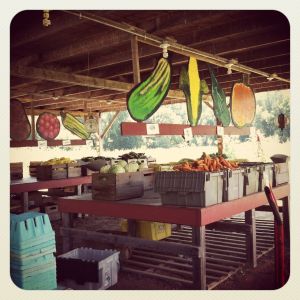
We have a membership in a community supported farm. Our subscription buys us a once-weekly share of vegetables, which we go to the farm to pick up.
Eating local immediately turns into eating seasonally. After the abundance of August, eating local suddenly seems to be all about what’s not available: lemons, asparagus, strawberries, spinach… So eating seasonally becomes another exercise in gratitude. Everything we have in November (beets, cabbage, butternut, potatoes, carrots…) is such a miracle. I love digging around in the produce drawer and finding a mealful of veggies months after our last visit to the farm. The thing that strikes me most about eating seasonally isn’t so much how hard it is, but how easy it is to eat without principle. In fact we eat mostly non-locally and non-seasonally. Grocery store shopping is all about a strict separation between your consciousness and the origins of the food. The uniformity of grocery stores and of food products obscures everything about where food comes from, how it’s grown, who grows it, how it gets to you. The abundance of acres-big supermarkets quiets the mind’s curiosity about limits: geographical, seasonal or otherwise. And yet, when we ran out of carrots in June I did not put them on the shopping list. California carrots are always just down the road at the 24-hour supermarket. But I knew, just around the agricultural corner, our farm share would one day include some slender, fresh-skinned, neon-colored new carrots. Could we wait..? Yes, we can wait! With gratitude all is possible.
And so it is with energy that comes out of a wall socket. The modern electric grid is all about consistently supplying 120 volts of electricity 24-7: no blips, no brownouts, no shortages, outages or limits of any kind. There is no rhythm to using grid electricity: no batches or bucketfuls, no deliveries or open hours, no budget, no end… Or so it seems. As with all systems, the way we use electricity has evolved in response to the way it is supplied, and the expectations around what constitutes quality energy evolves in response to how we use electricity. If electricity were only available for 12 hours every day (a situation I think would work just fine for most people), there would never be little electric appliances that set themselves back to a zero state every time they lose power (those blinking electric clocks are tiny billboards saying “We feel entitled to unlimited, uninterrupted electricity.”) It is very easy to use electricity thoughtlessly. Americans wanted an energy system without limits. Careful what you ask for.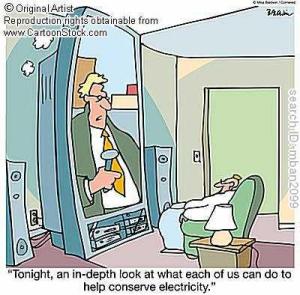
A troubling question to consider is, if your system does not limit your consumption is it ok to use as much as you can? With food maybe the consequences of doing so are clearly unethical: wasted food is firmly linked in our imagination to hungry people in… Ethiopia… or somewhere. With energy, if you don’t use it, or if you use a lot of it, does that affect your neighbors or someone in another country, far away? There aren’t kWh lying, uneaten on the plate. Is it wasted? Would it just have sat in the outlet, waiting for the next time if you don’t use it? If we use electricity, does that mean someone, somewhere else can’t? One of the visionaries of energy conservation, Linda Wigington, observed that we act as though the only consideration in how much energy we use is whether we can pay for it; that there is no ethical implication to using energy. Wait… is there?
In a way that I find peculiar to consider, we manage to have an element of seasonal energy eating in our household energy consumption. What I mean by that is there are limits imposed on our energy consumption that arise from environmental conditions. The way that we use energy responds to these conditions. It’s only seasonal in the sense that the constraints are sometimes related to time, but it’s not seasonal in the sense that it’s annually cyclical or related to the growing season. Instead of treating energy as a limitless commodity available in whatever quantity we want at a moments notice any time of day, night or season, we sometimes consider when we use energy so that we can use it in a way that takes advantage of our local energy environment. We choose this seasonality. We are grid-connected and we could just let the electricity flow out of the outlet without consideration to what, how or when we are doing it. That would be much the easiest way to do everything. But we have the tools, knowledge, curiosity and motivation to do otherwise, so sometimes we eat local energy.
The first seasonal energy eating I took note of was right after we installed our solar PV system. We weren’t yet metering the electricity, so anything we generated was sent to the electric utility without being counted. At the time I thought it best that we use that electricity while it was being generated, rather than let it disappear onto the grid, and then have to use the same electricity later (for a need that would have to be satisfied eventually). I talked about that in the post Getting the Big, Fat Pig of a Water Heater to Fire.
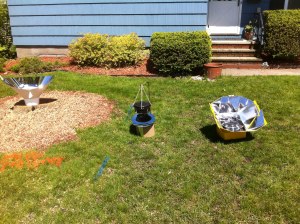
Here are three of my solar cookers in side-by-side tests. I have to orient them to the sun every hour or so.
My favorite seasonal energy eating is solar cooking. I’ve got several different kinds of solar cookers, and when it’s sunny out I try to put our evening meal out to cook by 10 am. This takes a lot of advance planning, which means I have to watch the weather report so I can have the raw meal ready in the morning on a sunny day. It also takes some attention throughout the day because my cookers need to follow the sun across the sky, which means I have to rotate them manually. I can do solar cooking in the winter on a really bright day, but the cooking window is small, so the meal has to be one that will cook quickly. Supermarket energy is easy. Seasonal energy eating takes planning, time, dedication.
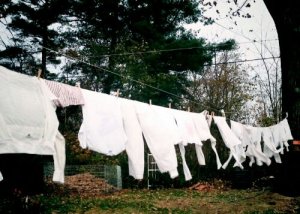
Drying laundry outside takes more time, can’t be done any ol’ day, and leaves heavy clothes a little dampish.
A very gratifying form of seasonal energy eating is drying our clothes outside. We discovered the electric dryer adds a third to a half to our normal daily electric use, and became much more motivated to hang our clothes to dry. That was all well and good in the summer when we could dry our clothes pretty much whenever we wanted. Come fall our clothes came off the line smelling like woodsmoke. In the dark part of winter there just wasn’t any outdoor drying happening. We’re now into the sunny part of winter and Nik has started hanging the clothes out. We can dry a load in one full sunny day, except the jeans are a little damp and they need a few minutes in front of the woodstove to finish them off. And that’s even with the clotheline on the shady side of the house! It does take about 20 minutes to hang a load on the line and about 5 minutes to bring it in. It only takes about 40 seconds to load the dryer.
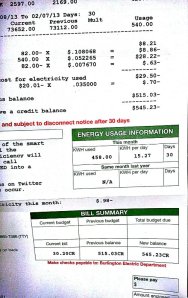
Our electric utility keeps track of how much electricity we generate and stores it as a credit on our electric account. We can only keep the credit within the last twelve months.
We are now faced with a particularly strange form of seasonal energy. We’ve made it through the darkest part of the year. Our electricity generation from the solar electric system is on the upswing. Our electricity use will decline a bit as we use electric lighting less and dry our clothes outside more. And we’ve got a huge credit on our electric bill. Due to some great, progressive regulations in Vermont we get credited at a higher rate than we pay for electricity. As a result, and also as a result of just having a very large PV system, and being generally energy misers, we have racked up a big credit with our electric utility. And now we know we’re not going to use it all, because from here on out, barring a strange meteorological event like the volcano eruption of 1885, the credit is just going to get bigger and bigger. After twelve months we start to lose the credit. It’s really just never going to get used, by us that is. So, is it ok to start using electricity like there is no tomorrow? If Linda Wigington is right, it’s unethical to use electricity profligately, even if it’s free! Yet, that’s our electricity that we made, without polluting, on our very own roof. It’s ours… Or is it, after we have fed it onto the grid? It’s a puzzle for sure. We don’t really have a way to use all that electricity, so it’s not really a question of going to the dark side entirely. It’s more like, is it ok to boil a whole kettle of water when we only want one cup of tea? – And I don’t mean that metaphorically!
Nice……from an environmental point of view, your excess energy has not been wasted…..some house next on the grid used that extra energy……to fix the accountancy glitch, why not inviting people with EV to stop by and charge their ‘tank’ in 45 mins (for a convenient $$ rate), while having a cup of tea?
By: Paolo Tedone on February 17, 2013
at 3:08 am
Paolo, thanks for the feedback! I love the idea of tea with EVs. I have come to understand that the most rewarding thing in life is making connections with people. As a popular bumper sticker proclaims, “The most important things in life are not things.”
Hope you stop by for some tea next time you’re in the neighborhood 😉
By: nik on February 17, 2013
at 1:56 pm
[…] specific, like a clothes dryer load, and figure out how much energy that uses. We now use our clothesline whenever it’s above 50 degrees and not raining, and know we’re savings some real […]
By: We Measure | Energy Freak Show on July 7, 2013
at 10:12 am
[…] to our annual energy budget. Even if we bought all of that from the utility at a peak rate (obviously we won’t) it would cost us about $750 to […]
By: Fill ‘er up, Sun! | Energy Freak Show on July 13, 2013
at 12:15 pm
Where’s your credit now? Are you still increasing the credit by $30 a month, or is the car charging station evening it all out?
By: Matthew Labate on October 6, 2013
at 11:13 am
Hi, Matt. We generally consume about 7-20 kWh/day to charge the car. At this point we’re still making quite a bit more than that on a sunny day, but pretty soon the gloom of November will set in, and the days will get shorter. Complicating it all, we’ve also installed a heat pump to heat the house, and that’s going to eat up a lot of electricity once it gets cold. So, no telling whether we’ll start chipping away at that credit, or it will continue to grow very slowly. We’ll let you know next Spring.
By: lilingy on October 10, 2013
at 8:55 pm